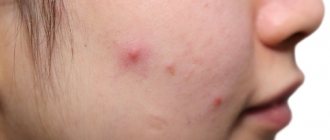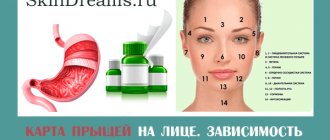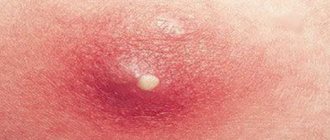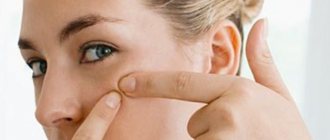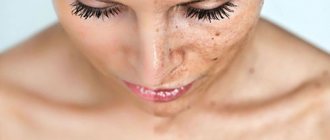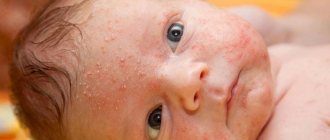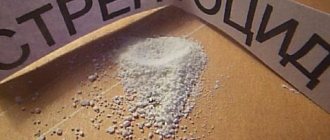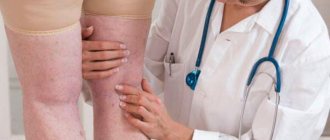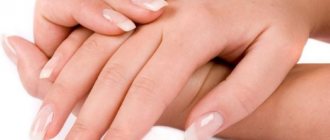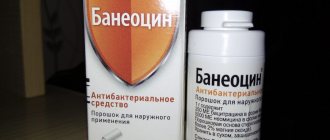Psychosomatics is a medical movement that studies the impact of emotional imbalance on the formation of physical diseases or pathologies. Acne on the face is considered one of these problems. Psychosomatics explains the connection between painful rashes at different stages of life and mental disorders in the body. It's worth learning more about this. Why does a rash appear in an adult woman? The psychosomatics of acne on the face and neck is described below.
What is acne?
Pimples on the skin are a reflection of difficulties from within, not only at the physiological level, but also at the level of thoughts and understanding of the picture of the world in general.
Most teenagers believe that clear skin means open doors to a society of attractive and successful people. Pimples in schoolchildren disrupt the child’s communication skills. What causes acne? What is the psychosomatics of their appearance? By focusing on this problem, you can actually solve it without purchasing a lot of cosmetics. Do you want to know how a person evaluates himself? Ask the person to talk about how they feel about their own skin. Any described problematic situation will decipher what exactly a person does not like about himself, what he is embarrassed about, what he is dissatisfied with. Talking about a pimple indicates that something is being given too much attention.
How to treat psychosomatic acne
Treatment of acne caused by stress must be approached comprehensively. This includes:
- Work on yourself. The very first thing you need to do is protect yourself from stress. You should learn to calmly react to changes in plans. We must remember that life is unpredictable, has many surprises, and some of them are not always pleasant. There is one important rule: everything that does not happen leads to the better. And it really works. A philosophical attitude to life will not only help get rid of rashes, but also prevent the occurrence of heart and vascular diseases.
- Proper nutrition. It is worth excluding fatty, fried, sweet and baked goods. The menu should be filled with fresh vegetables, fruits and cereals. As for drinks, you should say no to alcohol, soda and strong coffee. If acne appears on the forehead, then it is necessary to arrange a “fasting day”. This will cleanse the intestines.
- Daily care. Products that normalize the functioning of the sebaceous glands and help get rid of pathogens should be applied to the skin. This should be done only with good thoughts. Understand that no one is perfect, everyone has flaws. During the procedures, say only good things to yourself and think about the positive. Force yourself to truly believe it.
- Regular and complete rest. This could be hiking, yoga, reading, or doing any other favorite activity.
- Work with a specialist. This could be a psychologist or psychotherapist. A doctor can help you deal with your fears and worries.
Try to look at yourself in the mirror as little as possible. Psychotherapist Erickson Milton advised a woman who asked to help her son get rid of acne with the help of hypnosis to go on vacation away from civilization. During this time, her son was forbidden to look at himself in the mirror. When they returned home, the acne on the teenager’s face disappeared without a trace. This technique helps to get rid of fixation on the problem, and a person also copes with the habit of squeezing pimples on the face.
Dermatologist Whitney Bowie recommends finding companions. You can discuss the problem on the forums. This way you can find like-minded people who share sorrows and experiences. This will give you an understanding that you are not the only one with this problem, and that you can fight it.
And most importantly, look around, all people have acne and rashes. You just need to not concentrate on them. Try to protect yourself from what could cause them to appear, and if this fails, try to change your attitude towards the situation.
Mechanism of occurrence
Stressful conditions or blues provoke the production of the hormone adrenaline. It rapidly constricts some of the blood vessels, which negatively affects the condition of the skin. Another hormone that negatively affects the skin is a hormone that inhibits collagen biosynthesis and the skin restoration process.
Stress negatively affects digestion. The body is not able to fully convert food and take nutrients from it. As a result, toxins accumulate in the intestinal tract, negatively affecting the structure of the skin.
A huge number of bacteria live on the skin, including those that belong to pathogenic microflora. When immunity decreases, they begin to multiply rapidly, which becomes a factor in the occurrence of acne and other dermatological diseases.
Stressful situations also activate the sebaceous glands in the body. With a huge amount of sebum, the pores become clogged and comfortable conditions arise for the formation of pathogenic bacteria (viruses, microbes, fungi).
Appearance mechanism
It is difficult to believe in the connection between psychology and acne. Therefore, it is worthwhile to understand more deeply the mechanism of body processes. How do rashes appear:
- Stress or other negative emotions cause conflict, disagreement, and a large emotional outburst in the body.
- The body is accustomed to protecting itself. For this purpose, protein antibodies are produced. These substances cause acne.
We can conclude that this is a kind of allergic reaction to certain situations. It is not typical for all people.
Doctors name several other mechanisms for the development of the rash:
- As a result of stress, the digestive system begins to work poorly. The required amount of nutrients is not retained in the body, but toxins remain. This leads to acne.
- Negative emotions reduce immunity. The body's defenses weaken. Microorganisms located on the skin easily get inside and cause an inflammatory process.
Causes
According to the teachings of Louise Hay about the psychosomatics of acne on the face, the main circumstances of its occurrence include:
- Violation of psychological contact with mother. If in childhood the baby does not receive enough love and affection from his parents, then this can become a factor in the appearance of acne in adolescence.
- Ignoring the baby's emotions. In this case, the cause of skin problems will be the authoritarianism of the father or mother, the imposition of one’s own thoughts and principles, prohibitions on the interests and preferences of the child.
- Excessive concern. It has the same effect as absolute neglect.
- Rejection of one's appearance. It often occurs in adolescence, if children have a painful dependence on the opinions of people around them.
- Internal disagreements. The appearance of a rash can indicate difficulties in communication or in establishing contact. For schoolchildren, this may mean fear of communicating with the opposite sex.
- Conditional benefit. In certain cases, a person wants to attract attention to himself, but does not understand how to do this. In this case, the disease takes on this function.
- An attempt to inherit the manners, appearance and behavior of an idol. In this case, a person selects a standard for himself and diligently copies it, over time moving away from his own individuality.
- Intolerance. In the course of solving certain difficulties, a person should renounce personal principles.
- Problems at work. Acne often occurs in adults when, for example, they change jobs and try to join a new team. Emotional tension affects the condition of the skin. Acne may also be caused by poor relationships with management or difficult working conditions.
- Conflicts in the family. In this case, acne occurs more in women. Misunderstandings and emotional restraint on the part of the spouse, constant brawls and tense relationships with other family members have every chance of triggering the appearance of pimples.
- Problems with money. In this case, acne occurs more often among representatives of the stronger sex, since they endure their insolvency much more seriously.
- Self-punishment. And Liz Burbo calls this reason for the psychosomatics of acne on the face one of the main ones. After committing a dishonest act, a person feels guilty and unconsciously begins to castigate himself.
Finding the sources of psychosomatics of acne on the face using “Spiritual Integration”
Konstantin Dovlatov, author of “ Spiritual Integration ” explains that victims can independently, without the help of a psychologist, determine the metaphysical causes of their illnesses and life problems.
To do this, patients need to master the skills of his author’s system. It is based on the most effective psychotechnologies from various movements and schools, supplemented by personal techniques and psychologist discoveries.
Having completed the training and mastered the techniques of the system, course participants receive a practical opportunity to realize and apply their mental capabilities to 110%, to enter into direct dialogue with their own soul.
Training in the techniques of “Spiritual Integration” can be completed in live training and online .
Psychosomatics of acne
Mental disorders and mental imbalance in the body are the factors that contribute to the occurrence of problem areas on the skin.
Louise Hay about the psychosomatics of acne on the face says that often the cause is a violation of plans made in advance. A person has composed an impeccable sequence of his own actions, but due to small obstacles or absurd actions, everything collapses. Outbursts of discontent and anger arise inside, having the image of a depressive reaction.
By tracking the chronology of incidents, especially if the rashes have a clear cyclicity, it is possible to establish what events coincide with the moment the pimples appeared. Prolonged inflammatory processes affecting deep dermatological structures, the presence of subcutaneous painful elements can result in low self-esteem.
How does psychosomatic acne occur?
Psychosomatism explains the appearance of a pathological amount of acne by various psychological disorders in the body.
p, blockquote 3,0,0,0,0 —>
p, blockquote 4,0,0,0,0 —>
The causes of acne are as follows:
p, blockquote 5,0,0,0,0 —>
- Stressful situations or prolonged depression are strong provocateurs for the production of the hormone adrenaline. A side effect of its release is the narrowing of skin blood vessels, which slows down skin metabolism.
- The consequence of stress is a negative impact on the functioning of the digestive system. It cannot completely process the products entering the stomach, as a result of which the body not only receives less nutrients, but also accumulates toxins in the intestines.
- Psychological instability provokes a decrease in immunity, as a result of which pathogenic microorganisms living on the skin begin to actively develop.
- Emotional experiences provoke increased activity of the sebaceous glands and excess production of sebum. As a result, the pores become clogged and pathogenic microorganisms receive a favorable environment for reproduction.
All these prerequisites for the occurrence of pimples are not rare. Psychosomatics is an exact science, and its data explains why in some cases dermatological treatment of rashes is useless.
p, blockquote 6,0,0,0,0 —>
The meaning of acne
Pimples do not appear randomly throughout the body. Each area of pimple occurrence has a specific meaning, as do the following factors:
- If acne is permanent and does not disappear with prolonged treatment, this indicates low self-esteem. In the soul of a person, internal disagreement is brewing due to the fact of self-rejection.
- Pimples that appear only occasionally indicate that the individual from time to time wants to close himself off from the society around him, to retire from the world. The stronger this desire, the more acne appears on the skin.
- When the number of pimples unexpectedly increases, this is an immediate sign that serious stress has occurred in a person’s life, which has activated psychosomatic processes again.
- As for gender, pimples appear on the face of girls, and on the back of the stronger sex. For what reason does this happen according to the teachings of psychosomatics:
- Women experience emotional difficulties. Often accompanying processes are tears and conversations with friends and family, for this reason acne exanthema has an open appearance.
- Men tend to keep all anxieties and feelings inside themselves, which is why inflammation has a hidden appearance.
The place of its occurrence can tell more about the factors responsible for the appearance of psychosomatic acne.
Causes of psychosomatic acne in the works of famous authors
Louise Hay sees self-rejection and self-loathing as the causes of acne. Acne, in her opinion, means small outbursts of anger, and ulcers mean a violent manifestation of anger and anger.
Lise Bourbeau argues that skin symbolizes a person's ability to value himself in the face of the world around him.
The psychologist writes that if pimples appear and disappear, this indicates impatience and unwillingness to come to terms with the disruption of plans, which are accompanied by slight suppressed anger. She believes that the location of the part of the body where acne appears will serve as a clue in which area a person is experiencing negative emotions.
Liz Burbo writes that acne appears as a sign of a subconscious desire to push others away and not allow oneself to be examined, especially up close. In her opinion, a person suffering from acne does not love himself, does not know how to love himself, and does not respect himself enough.
The psychologist notes that acne is a sign of a very sensitive but withdrawn nature (as almost everyone becomes during adolescence).
If we talk about an adult, acne, according to Liz Burbo, indicates that a person is trying to be different from what he is because of the desire to please loved ones. The psychologist identifies another reason for the appearance of acne is that a person continues to suffer from psychological trauma received in adolescence.
V. Sinelnikov sees the main reason for the appearance of acne as dissatisfaction with oneself, with one’s appearance (typical of adolescence). The psychotherapist believes that with the help of this disease, teenagers learn a lesson in self-love and learn to accept themselves and their sexuality for who they are.
Bodo Baginski and Sharamon Shalila explain this ailment from a Reiki perspective. They claim that acne is a sign that something in you wants to break through, to become visible, but the person suppresses it out of fear, uncertainty and shame. This conflict manifests itself on the skin as acne.
Another psychosomatics specialist, J. Reno, considers the appearance of acne to be a consequence of growing up and moral experiences hidden from parents.
O.G. Torsunov claims that acne arises from the presence in the character of such qualities as aimlessness, sloppiness, laziness, pessimism, and greed. He explains that as a result of the activation of the lower centers in adolescence, character flaws hidden in a person awaken. And due to disturbances in hormonal functions that are still unstable at this age, the secretion of the sebaceous glands increases, which leads to the appearance of acne.
Acne on the face
Infrequent or small pimples on the face may appear in those who have a negative attitude towards changing personal plans. Large and intense acne indicates rejection of oneself and the surrounding society. The individual is simply unable and unwilling to come to terms with his own actions and their results.
The part of the face where the rash occurs is also important. According to psychosomatics, the causes of acne on the face are as follows:
- On the forehead - a person is afraid of looking funny and stupid and demands the greatest seriousness and responsibility from himself.
- On the chin - continuous conflict situations with loved ones have a great impact on a person’s mood.
- In the nose - the degree of anxiety reaches its peak.
- On the bridge of the nose, pimples appear due to the constant blocking of feelings and the accumulation of powerful anger from within.
- Under the eyes - a prerequisite for stress, perhaps, is great fatigue.
- On the cheeks - a person feels abandoned and believes that no one needs him.
- On the lips - the individual is fixated on himself and stuck on experiences.
Acne on the face is a fairly common picture. In order to get rid of them, psychosomatics recommends adjusting your attitude towards yourself and the people around you.
The relationship between the location of the rash and the nature of the disorders
Experts involved in psychosomatics say that the location of the rash depends on the nature of the problems. The body is divided into several zones, each of which has acne of a specific origin:
- back (rashes in this area most often bother men);
- neck;
- buttocks (the rash appears quite rarely in this area);
- face (several more small ones are distinguished in this area);
- body.
The nature of the appearance and disappearance of acne may also indicate certain conditions:
Acne does not go away from the skin for a long time, the problem has become chronic - there is an internal conflict, problems with self-esteem. The periodic appearance of acne indicates a person’s attempts to “withdraw into himself,” hide problems from the outside world, and protect himself from all irritants. The gradual deterioration of the problem indicates advanced psychosomatic processes.
Back
Acne on the back often bothers men. In psychosomatics, this is associated with the desire to hide one’s experiences and appear stronger. It turns out the hidden nature of the disease. Problem skin in this area is a sign of a strong person. Or a weak person who has taken on enormous responsibility, problems, and cannot stand it. If acne affects the lower back, the person is vulnerable, emotional, withdrawn, and has problems with social adaptation.
Neck
Pimples on the neck are not so common. Experts in psychosomatics associate this phenomenon with the body’s reaction to something new. Changes in life cause a lot of emotions. Even if they are positive, this is a sharp change and surge in the body. New – leaving the comfort zone, creating new conditions to which a person does not adapt so quickly. Therefore, reluctance to accept new things causes conflict and skin problems.
Buttocks
Pimples on the buttocks indicate problems in a person’s life that are associated with everyday affairs. Psychologists say that perhaps such patients are somehow humiliated, feel insecure and powerless.
Face
The face is the area that is most prone to acne. Therefore, several more small separate areas were identified on it:
- Forehead.
- Chin.
- Nose.
- Bridge of the nose.
- Areas under the eyes.
- Cheeks.
- Lips, jaw.
Large pimples appear in those who have an internal conflict, cannot understand their desires, feelings, and neglect themselves. Minor rashes are common among perfectionists who do not accept change. If the forehead suffers, the person is too demanding of himself and does not forgive mistakes or indulgences. However, in life, not everything can go the way you want. Such situations cause conflict. Psychosomatics claims that a patient with acne on the chin often conflicts with people, which leads to stress and an outburst of negative emotions. If a rash appears on the nose, it is a sign of anxiety, uncertainty, and fear. The bridge of the nose suffers when holding back negative emotions, trying to be restrained, indifferent. The skin under the eyes becomes covered with acne due to severe mental fatigue. Acne on the cheeks often indicates oppression of a person due to feelings of loneliness. The lips and jaw become covered with acne due to isolation and the accumulation of any experiences.
Body
When inflammation appears on the skin of the chest, a person needs to pay attention to his surroundings. This is how the body reacts to humiliation from others. Hands and armpits become covered with acne due to holding back positive emotions. The patient feels warm feelings and love for someone. But for certain reasons they are hidden and not made public. When obstacles arise before turning plans into reality, pimples appear on the legs.
How to get rid
Help is needed already in the initial stages of acne. Skin problems can only be the mildest challenge. As immunity decreases, the risk of other diseases increases. If you cannot find out the physiological causes of the rash, you should contact a somatologist, psychologist, psychotherapist, or neurologist.
- Hypnosis is a way to relax the patient. As a result of the procedure, almost all processes in the body are normalized. The main goal is to liberate a person.
- Cognitive therapy is training aimed at personal growth, increasing self-esteem, improving self-perception, and strengthening character.
- Gelstatt therapy – sessions that help you realize the significance of the present. It is in the past that all problems are often buried. And returning to it, a person does not realize reality. But problems exist now. This is what the specialist is trying to draw the patient’s attention to.
- Holotropic breathing is intense breathing that removes carbon dioxide and fills with oxygen. After the procedure, the patient is in a state of elevation. This allows a person to open up.
Acne on the back
If the area of the rash is the back, the person is burdened with a difficult burden and is unable to cope with it due to moral pressure. By expressing himself more easily, he has taken on too much responsibility, which overwhelms him.
If acne appears on the lower back, its carrier is a very receptive and vulnerable soul, which is characterized by a feeling of insecurity, as well as problems with communication.
Louise Hay and her table of diseases
Louise Hay is the author of 15 well-known publications on psychology and psychosomatics. Her books not only helped a large number of people overcome psychosomatic illnesses, they became a real discovery in this area. One of the publications presents a table of diseases and the root causes that provoke them. Here's what the table says about the appearance of acne:
The table presents not only the causes of skin problems, but also parting words with which they can be solved. Do not take this technique with irony, since it is recognized by official medicine. Louise Hay is called the “Queen of Affirmations” because her chart really works. And here is what the author says about the occurrence of acne:
Patients who are seriously interested in this theory of psychosomatics have experienced it themselves, and here are the results of treatment they note:
- The author's parting words heal body and soul;
- Correct use of the technique allows you to get a surge of strength and energy;
- Following all the advice cures any disease.
To try the technique for yourself, it is enough to learn the “mantra”, which is presented in the last column, and repeat it at least 2 times daily. When you yourself believe in what you say, you will see the result with your own eyes.
Psychosomatic assistance in therapy
First, the need for the assistance of somatologists as a comprehensive treatment for acne is considered. You may need to seek help from a neurologist, a psychologist, or a psychotherapist.
It should be borne in mind that psychosomatic support is not about healing the body, but about adjusting the internal state of the body and eliminating emotional difficulties. With prolonged exposure to tension, the immune system weakens, losing the ability to fight pathological representatives. A person is exposed not only to inflammatory processes and dermatological problems, but also to viral infections and colds.
Psychosomatics is rapidly using appropriate methods of psychotherapeutic influence:
- hypnosis;
- cognitive therapy;
- restoration and adjustment of individual settings;
- holotropic breathing;
- gelstatt treatment.
How to help yourself?
It is necessary to fight the problem both from the inside and the outside. Only an integrated approach to solving the problem will bear full fruit. People who often experience nervous tension and suffer from skin rashes can only help themselves if they wish. Relatives and friends can only help with this, but if you can’t wait for support, you have to rely only on yourself. In more severe cases, if a person cannot cope with the psychological stress on his own, drug therapy cannot be avoided.
Drug therapy
Inflammatory skin problems that appear against the background of frequent stress must be eliminated not only with the help of topical antiseptics, but also with the help of sedatives. The following drugs are indicated for people with unstable psycho-emotional background:
- "Novopassit";
- Valerian tincture;
- motherwort tincture.
Pills can help cope with stress
These medications have a good calming effect, are harmless to the body and have virtually no contraindications. A course of sedatives will help normalize a person’s psycho-emotional background and the functioning of hormonal systems. It is necessary to take sedatives for a long enough period to even out the hormonal levels.
You also cannot do without the use of local antiseptics and antibiotics, especially if not a single boil has formed at the site of the pimple on the body. In this case, drugs such as salicylic acid, boric alcohol, ichthyol ointment, Vishnevsky ointment, etc. will come to the rescue.
You should not hope that the problem will go away on its own by taking sedatives alone, since the problem has already matured.
The use of medications is not always sufficient when acne is associated with psychosomatic causes. Additionally, alternative solution methods come to the rescue in this case.
Gelstatt therapy
A method of psychotherapy that can help the patient find out what is happening to him at the moment. This definition is considered the basis of assistance. Gelstatt therapists teach that every person has his own past, which often leaves negative traces, and in addition, a future about which most people dream and fantasize. This method helps with psychosomatic acne on the face and chin. But not a single person thinks about the current time of existence, leaving to chance what is capable of delivering pleasure and delight.
How to understand that your acne is due to psychosomatics?
But what about acne? The fact is that all the factors that we listed in the previous section affect not only the sores that people experience, but also the appearance of acne.
Acne rosacea is also considered a full-fledged disease, which has its own symptoms and is treated with certain medications. Experts in psychosomatic medicine do not deny that acne on the face can also be caused by psychosomatics.
The reasons for this are no different from the psychological factors that provoke the occurrence of other diseases.
If you are punishing yourself
For example, acne may well appear from self-punishment.
Let's say a girl really wants to look good and have ideal facial features, figure, and so on. But for certain reasons she doesn’t succeed, and she begins to reproach herself for this, blaming herself for allegedly being to blame for not looking good enough. As a result, she begins to believe that she deserves punishment.
This manifests itself, first of all, externally - acne occurs that has no objective reason. And a paradox arises: You look bad because you want to look good too much.
Naturally, this needs to be treated by a psychologist, because failure to accept one’s own body and appearance is a serious problem.
When you give yourself problems with your appearance
Suggestion also takes place, although this factor is not so common in the case of psychosomatic acne. In this situation, they occur if you are sure or you are assured that you should have acne.
For example, due to the fact that you perform certain actions. Let's say you think that acne occurs because you sit at the computer too much.
Naturally, this simply cannot be - acne occurs for completely different reasons. But if a person begins to believe in it too much, then he really notices the appearance of rashes.
You are in conflict with yourself
Internal conflicts also have a huge impact on our health. For example, when it seems to you that you need to do a certain thing and that it is really necessary, but in reality you experience uncertainty and internal rejection, this causes severe stress.
Of course, this will be a huge blow to the body, which will subsequently contribute to the appearance of psychosomatic acne on the face.
Of course, girls are the ones who suffer most from these problems. Ladies are more likely to worry about their appearance, which results in severe neuroses and health problems.
Holotropic Breathwork
A method of therapy for psychosomatic acne on the face and shoulders, which involves rapid breathing (hyperventilation). Carbon dioxide leaves the patient's blood, causing compression of the blood vessels, as well as the brain. Inhibitory movements are activated in the cortex, which puts a person in a peculiar mood, accompanied by euphoria and hallucinations.
Experts in the field of psychosomatics, who are considered adherents of the method, believe that in this state a person is able to release his own internal problems and anxieties that were previously repressed into the subconscious.
Which organ is wrong?
In Chinese traditional medicine, it is believed that skin inflammation is a consequence of problems with internal organs. In particular, painful and internal pimples on the sides of the chin in women indicate a hormonal imbalance in the body.
These hormonal changes can be caused by puberty, the menstrual cycle, menopause, birth control medications, and sometimes PCOS (polycystic ovary syndrome).
Hormonal fluctuations can also be triggered by diet (in particular, sugar-containing foods and foods high in carbohydrates), as well as irregular sleep and stress. These factors lead to increased sebum production.
In this case, you should reduce your intake of sugar and carbohydrates and ensure that you get good sleep.
Pimples on the chin and directly in the lower part of the face indicate problems with the digestive system. This is often accompanied by constipation, stomach upsets, and intestinal colic. Therefore, a woman should pay attention to her digestion.
Eating fiber, which will cleanse the body, as well as vegetables and fruits will help fight acne in this area.
How to deal with acne with psychosomatics
Treating only external manifestations will not bring the expected result. The situation may improve. But until the true cause is eliminated, acne will not disappear.
In such situations, solving the problem must be approached comprehensively. Psychological help is also needed.
The most common treatment methods:
- Gestalt therapy. This is a set of special techniques that allow a person to realize what is happening to him at the present moment. The technique involves the use of various techniques. It is important that contact and dialogue be established between the patient and the Gestalt therapist. During therapy, the patient is helped to identify those parts of his own personality that he rejects. This is the first step towards accepting these traits in yourself and restoring the integrity of your personality.
- Hypnosis. The state into which the patient is plunged allows the body to relax. Breathing, heartbeat and the functioning of internal organs are normalized - something that was disturbed by stress. In the process of work, hidden or forgotten fears that caused the problem are revealed.
- Cognitive therapy. The process is aimed at working with cognitive functions: language, attention, visual - spatial perception. Trainings allow you to better perceive yourself as a person and have a beneficial effect on self-esteem. In stressful or other unpleasant situations, cognitive function may be impaired. Their restoration, as it were, triggers the reverse mechanism.
- Holotropic breathing. This is a special breathing technique in which the patient must breathe frequently and quickly. As a result of prolonged hyperventilation, the level of carbon dioxide decreases and blood vessels narrow. Oxygen starvation begins. This leads to inhibition of the cerebral cortex and more active work of the subcortex. In this way, all experiences that have been repressed from consciousness are released.
How to get rid of acne?
Only a multidisciplinary approach to the problem will help completely eradicate it and its consequences. Treatment is divided into two groups of measures:
- Cosmetic – aimed at eliminating existing imperfections and improving the condition of the skin.
- Psychological – you need to prevent the emergence of new inflammations, “work on mistakes” with yourself.
Separately, you should not forget about nutrition. Refusal of fatty foods, sweets and alcohol will help the body remove all excess and quickly normalize the functioning of internal organs.
Cosmetic treatment
Treatment of skin pathologies should begin with proper care, including the use of various means:
- Shower twice a day and as needed. If you can’t go shopping, then at least wipe your body with a damp towel.
- Using soap that does not dry out the skin.
- Use of antibacterial agents - hydrogen peroxide, salicylic acid. They will dry out inflammation and remove bacteria from the skin.
- Using baby cream or oil to moisturize the skin. But their texture should be light and quickly absorbed.
In addition, we can say about the need to regularly change wet and dirty clothes. No antiseptics will help if you constantly walk around in a sweaty T-shirt or worn-out sweater. Things need to be washed regularly, and their smell should be pleasant, but not pungent.
Work on yourself
Until your head clears up, your skin will not become clear, and therefore it is advisable to use:
- Psychotherapy sessions - they will help to identify problems, increase self-esteem, and get rid of complexes.
- Hypnosis will help you open up. A person himself does not always realize why he is nervous, but a specialist will be able to find out.
- Gelstatt therapy - such sessions will help you understand that you don’t need to worry about the past, but you need to live in the present and enjoy it.
- Holotropic breathing - frequent deep breaths using a special technique will allow you to relax, feel lightness and open up.
Once the problem is identified, you can begin to fix it. The support of loved ones at this stage is no less important than high-quality creams and breathable clothing.
Types of acne and their meaning
It is possible to establish psychosomatics only by discarding the standard causes of the rash - staphylococcus and streptococcus, prickly heat, diseases of the digestive system, allergies. If a doctor or person independently begins to suspect that psychosomatics has caused acne in the back area, then now you can begin to look for the cause. And the nature of the skin rashes will help with this:
- A mild, small rash indicates ongoing problems. These may even be small things, but if because of them a person is nervous and cannot calm down, then the skin problem will not be solved.
- Acne indicates low self-esteem. A person does not accept himself, is ashamed, is afraid to appear real.
- Shy and shy people have pimples of normal size, do not fester, and their number depends on how much the person wants to abstract himself from others.
- Rare pimples in certain areas indicate a dislike of change.
In addition to the type of acne, for diagnosis you need to look at the frequency and quantity of their appearance. If after a certain situation (a scandal at home, the boss shouted, failed to make friends with someone) there are more skin rashes, then this particular factor is psychosomatic. Everyone has their own stresses, fears and difficulties in life. Therefore, you need to immediately assess the character, find weaknesses in order to understand what caused the illness.
Acne inflammation on the back as a consequence of psychosomatics
